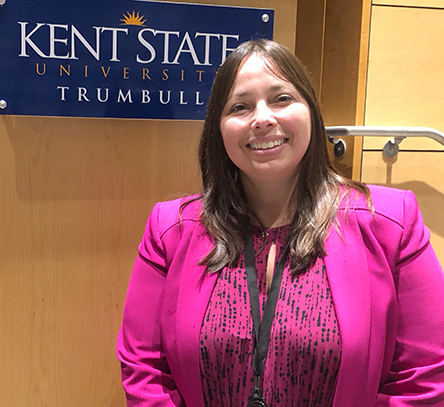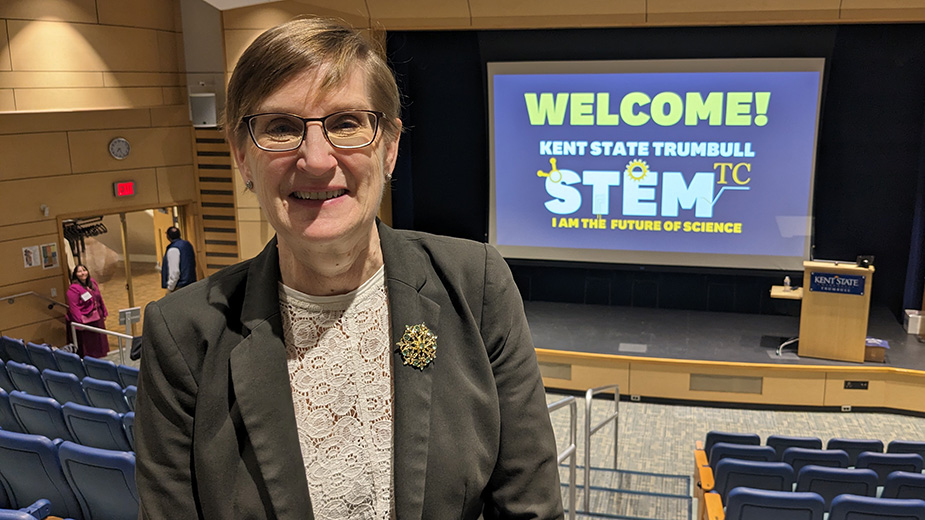WARREN, Ohio – The arrival of Intel Inc. near Columbus will provide opportunities for thousands of new jobs in Ohio, including STEM careers for women.
Calling Intel’s massive campus under development the “Silicon Heartland” project, Jennifer Clark, a production department manager with Intel, addressed girls attending the STEM TC program March 17 at the Trumbull campus of Kent State University about the new semiconductor fabrication plant under construction in the New Albany area. It is designed to help resolve concerns about innovation and the supply chain in the United States.
For Clark, the Intel project was an opportunity to move back to Ohio, closer to her mother in Canton. For the sophomore and junior girls in that room interested in STEM careers, Clark told them the manufacturing complex would offer the opportunity to venture only a couple of hours from home and use their interests in the sciences and technology in a career with an exciting future.
Nearly everything these students touch has semiconductor microchips inside: communications, computing, health care, consumer goods, smart energy and transportation industries. All use billions of chips. In 2021 alone, enough chips were made for each person on the planet to have 140 new chips, Clark said.
Intel has eight fabrication plants planned for the site in New Albany, each the size of several football fields and each representing a $10 billion to $15 billion investment, Clark said.
The project is creating 7,000 construction jobs and then 3,000 production jobs at completion. Those 3,000 jobs will employ both technicians and engineers, which require various associate degrees and baccalaureates.
Intel also has invested in semiconductor education and research, committing up to $50 million in the United States.
Universities such as Kent State have already benefited from that investment and have started programs. Through this year’s Summer Institute, Kent State will offer undergraduate students the opportunity to learn more about the manufacture of microchips and semiconductors.
Unlike the manufacturing plants of the past, Clark described the clean atmosphere of a processor chip manufacturer – 1,000 times cleaner than a hospital operating room – because they protect the semiconductor chips from the humans who work on them. She also provided students with typical degrees or training they would need to join the company. And she said Intel has ambitious goals to reach the same percentage of women in their workforce as the percentage of women in the population.
SHORTAGE OF WOMEN IN STEM
While more women are pursuing degrees and careers in the STEM fields, in 2019 the U.S. Bureau of the Census showed only 27% of those working in STEM jobs are women.
When teenage girls are making decisions about what their next steps will be after high school, those without a mentor, those who don’t know any women who work in STEM, can find it that much harder to choose STEM paths for themselves.

“We know that women are not as strongly represented in many of the science, technology, engineering and math areas as they should be. And so we want to help those women see their choices. So that is why we do this specifically for young women,” said Dr. Peggy Shadduck, vice president for regional campuses and dean of the College of Applied and Technical Studies at Trumbull.
“The reality is both women and men are very capable of doing all different kinds of things and they should be following the pathways that give them both the most joy in their lives and provide the contributions that they want to provide to society,” Shadduck said.
About 200 high school junior and sophomore girls attended STEM TC at Kent Trumbull and got the opportunity to meet more than 30 women in the STEM fields and hear how they can use their own interests toward rewarding careers.
“We call it STEM TC,” Shadduck said. “It is an opportunity for young women who are interested in pursuing any kind of a STEM career to go deeper into those interests and see some opportunities that they might have, explore both their own interests and then things that they might not have been aware of before, learn more about where they can go with their life and their career.”
As the opening speaker at the conference, Shadduck explained the importance of exploring the variety of careers available. While chemistry, biology and physics are the basics, she said there are specialties branching from their understanding of those subjects that can lead to a variety of fields.
“You have to love what you do,” Shadduck told the students. “If you’re not getting personal satisfaction from what you are doing, you are in the wrong career … You want to get up in the morning and you want to be ready to say, ‘Yep, I might have some big challenges at work today. But I’m ready to go.’ ”
While emphasizing the importance of choosing a career that gives them energy, Shadduck also suggested students consider other factors when making decisions about their careers.
For instance, do they enjoy developing new knowledge or applying it? Thinking or working hands on? Days that have less or more variety? Do they work better alone or with a team? Do they want more income or less?
As an example of the difference between two important careers, Shadduck talked about the difference between being a garbage collector and a doctor, noting both are vitally important to human health. But she challenged the girls: Which career would be more personally satisfying.
LEADING BY EXAMPLE
Women in a variety of STEM fields told the students how their careers provide them with energy and how they keep going, even when the task is difficult.
Students at the STEM TC heard directly from women working in the fields of health care, criminal intelligence, veterinary technology, pharmacy, chemistry, physics, engineering, radiology and mathematics.
Within those sessions, the speakers talked about what they do at work and what others who study the same subjects can do.
After reciting a long list of medical fields and specialties with the students, Dr. Kimberly Jackson, a family medicine physician in East Liverpool, talked about how in her practice she helps many people, but in other cases refers patients to a specialist.
“That’s what I love about medicine,” Jackson told the students who had gathered in her breakout session. “There’s something for everybody.”
Criminal investigation specialists Andrea Bujorian and Jamie Papesh explained their careers at the state Bureau of Criminal Investigation.
Bujorian and Papesh told how their research into people with information about a crime is often gathered from cellphones and social media footprints, which can be used to solve crimes and provide evidence to build strong cases.
The students got an opportunity to see a snapshot of what these women’s lives are like, starting with what education they required, the typical things they do at work and how they try to balance family and career.
The conference also allowed students to hear from other young women with some lofty goals. Several expressed their own doubts and feelings – and that imposter syndrome can be legitimate.
Two of them admitted to considering starting a coffee shop during those moments of doubt when a class or program became very difficult. But both women explained the importance of persevering and getting that degree, even during their moments of doubt.
“Just know you belong here,” said Kristin Sobie, who is studying for her doctorate at Kent.
Sobie noted that STEM remains a male dominated field – but women can still love science, mathematics and engineering as much as the next student.
Shaddock said perhaps the best way to open up people’s minds is to provide examples that women belong in STEM careers.
The career women at the conference can influence the students by showing them, “We’ve done this. We’ve really enjoyed this. We welcome you to come into this kind of area as well.”
Pictured at top: Jennifer Clark, a production development manager at Intel, talked to students about future STEM career possibilities at the chip fabrication plants under construction in New Albany, Ohio.
